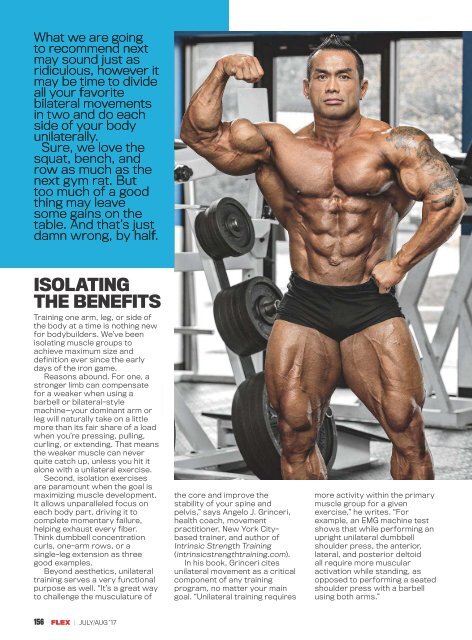Flex_USA_JulyAugust_2017_2
You also want an ePaper? Increase the reach of your titles
YUMPU automatically turns print PDFs into web optimized ePapers that Google loves.
What we are going<br />
to recommend next<br />
may sound just as<br />
ridiculous, however it<br />
may be time to divide<br />
all your favorite<br />
bilateral movements<br />
in two and do each<br />
side of your body<br />
unilaterally.<br />
Sure, we love the<br />
squat, bench, and<br />
row as much as the<br />
next gym rat. But<br />
too much of a good<br />
thing may leave<br />
some gains on the<br />
table. And that’s just<br />
damn wrong, by half.<br />
ISOLATING<br />
THE BENEFITS<br />
Training one arm, leg, or side of<br />
the body at a time is nothing new<br />
for bodybuilders. We’ve been<br />
isolating muscle groups to<br />
achieve maximum size and<br />
definition ever since the early<br />
days of the iron game.<br />
Reasons abound. For one, a<br />
stronger limb can compensate<br />
for a weaker when using a<br />
barbell or bilateral-style<br />
machine—your dominant arm or<br />
leg will naturally take on a little<br />
more than its fair share of a load<br />
when you’re pressing, pulling,<br />
curling, or extending. That means<br />
the weaker muscle can never<br />
quite catch up, unless you hit it<br />
alone with a unilateral exercise.<br />
Second, isolation exercises<br />
are paramount when the goal is<br />
maximizing muscle development.<br />
It allows unparalleled focus on<br />
each body part, driving it to<br />
complete momentary failure,<br />
helping exhaust every fiber.<br />
Think dumbbell concentration<br />
curls, one-arm rows, or a<br />
single-leg extension as three<br />
good examples.<br />
Beyond aesthetics, unilateral<br />
training serves a very functional<br />
purpose as well. “It’s a great way<br />
to challenge the musculature of<br />
the core and improve the<br />
stability of your spine and<br />
pelvis,” says Angelo J. Grinceri,<br />
health coach, movement<br />
practitioner, New York Citybased<br />
trainer, and author of<br />
Intrinsic Strength Training<br />
(intrinsicstrengthtraining.com).<br />
In his book, Grinceri cites<br />
unilateral movement as a critical<br />
component of any training<br />
program, no matter your main<br />
goal. “Unilateral training requires<br />
more activity within the primary<br />
muscle group for a given<br />
exercise,” he writes. “For<br />
example, an EMG machine test<br />
shows that while performing an<br />
upright unilateral dumbbell<br />
shoulder press, the anterior,<br />
lateral, and posterior deltoid<br />
all require more muscular<br />
activation while standing, as<br />
opposed to performing a seated<br />
shoulder press with a barbell<br />
using both arms.”<br />
156 FLEX | JULY/AUG ’17

















